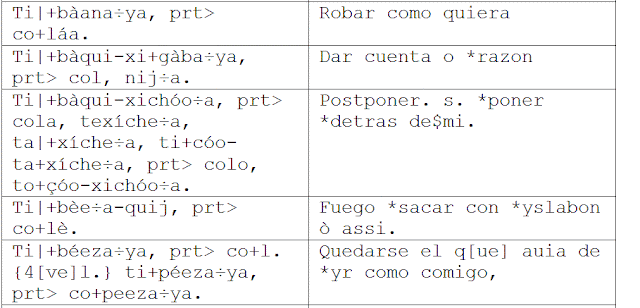I've undertaken the task of seeing whether it is possible to incorporate into our project the enormous work that Thom Smith Stark and his group put into creating an electronic and searchable version of the massive Cordova (1567) dictionary of Colonial Valley Zapotec. The big problem for modern researchers is that the Cordova dictionary is only Spanish - Zapotec, so it cannot be used to read documents.
There is tremendous potential here, but one initial challenge is figuring out the various notes, abbreviations, conventions, and file formats involved.
For example, I have one set of Word documents which are a reversal of the Cordova, now alphabetized Zapotec to Spanish. Here is an image of part of one of them:
Here are my guesses about what some of the mark-up means. In the Spanish column, I think the asterisk must indicate a word for which a new entry ought to be created. So for the second word, I think this means make an entry for this Zapotec word under 'dar cuenta o razon' and also under 'razon, dar cuenta o'.
In the Zapotec, I think the | after /ti/ is showing that this is a prefix. I don't know exactly why there is also a + symbol at this point. The ÷ precedes a clitic /=a/. (Cordova's convention was to list all the verbs in the 1st person habitual.)
In Cordova's dictionary, at the entry for a verb he lists the prefixes that are used for the preterite (or completive). So when we see prt> in TSS, that means that the completive prefix is what follows. Sometimes the completive attaches to a different form of the root.
For example, with ti-bee=a quij 'fuego sacar con yslabon o assi', the prt> co+lè means that the completive is co-lèe=a quij
For comparison, here is Cordova's entry for this verb
Although Córdova writes this all as one word tibèeaquij, Thom's morphological analysis is that the /=a/ is the 1st person. So the verb must end after this, and quij is a separate word. Thus - in Thom's dictionary seems to mean 'the following is a separate word'.


No comments:
Post a Comment